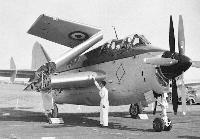Фотографии
-
Регистрационный номер: XD898 Gannet AS.4 XD898 of 816 Squadron, Royal Australian Navy, based at Nowra, New South Wales, 1967.
Самолёты на фотографии: Fairey Gannet - Великобритания - 1949
-
Регистрационный номер: WN404 Gannet AS.1 WN404 of 820 Squadron during its period on HMS 'Bulwark' in 1956/1957.
Самолёты на фотографии: Fairey Gannet - Великобритания - 1949
-
The Double Mamba consisted of a pair of Mambas mounted side-by-side and linked by a common gearbox. It was an efficient way of producing an engine with double the power output for little development outlay.
Самолёты на фотографии: Fairey Gannet - Великобритания - 1949
-
The first prototype Fairey Q in September 1949 around the time of its first flight, long before the rear cockpit, finlets and mock-up of the ventral radome had been added.
Самолёты на фотографии: Fairey Gannet - Великобритания - 1949
-
Weapons bay open and radome extended, the second prototype posing for the camera over a Royal Navy submarine. Of note are the wing fences briefly tested on the prototypes.
Самолёты на фотографии: Fairey Gannet - Великобритания - 1949
-
Регистрационный номер: WN348 WN348 wore the standard colours of production anti-submarine Gannets, consisting of extra dark sea grey upper- and sky lower-surfaces.
Самолёты на фотографии: Fairey Gannet - Великобритания - 1949
-
Регистрационный номер: XA425 Самолёты на фотографии: Fairey Gannet - Великобритания - 1949
-
From above the unusual spacing of the cockpits for the pilot, observer (navigator) and radio/radar operator are visible.
Самолёты на фотографии: Fairey Gannet - Великобритания - 1949
-
Регистрационный номер: XA510 XA510, here in March 1955, was the first production Gannet T.2.
Самолёты на фотографии: Fairey Gannet - Великобритания - 1949
-
Регистрационный номер: WN365 Although its role is revealed by the yellow trainer band around the rear fuselage, the only external clues that this is a Gannet T.2 are the periscope above the second cockpit and the lack of a radome. WN365 was the prototype of the version.
Самолёты на фотографии: Fairey Gannet - Великобритания - 1949
-
The third prototype was the first Gannet to have a rear cockpit, although a smaller transparency was used on the production aircraft. Note the feathered inner prop.
Самолёты на фотографии: Fairey Gannet - Великобритания - 1949
-
Регистрационный номер: VR546 VR546 after an aerodynamic mock up of the rear cockpit was added on its rear fuselage and the retractable 'dustbin' radar scanner had been moved aft to provide room for the new crew member.
Самолёты на фотографии: Fairey Gannet - Великобритания - 1949
-
Регистрационный номер: WN391 The large area of flaps and unsynchronised undercarriage retraction are evident in this take-off view of production Gannet AS.I WN391.
Самолёты на фотографии: Fairey Gannet - Великобритания - 1949
-
Регистрационный номер: XA435 Gannet AS.4 XA435 of 814 Squadron flying off HMS 'Eagle'. Note the rocket-rails under the wings.
Самолёты на фотографии: Fairey Gannet - Великобритания - 1949
-
Регистрационный номер: XG883 While the Gannet trainers retained the large weapons hay of the anti-submarine versions, they did not carry operational equipment. XG883 was a T.5.
Самолёты на фотографии: Fairey Gannet - Великобритания - 1949
-
The elaborate wing-fold mechanism of the Gannet allowed the aircraft to fit inside the Royal Navy's aircraft carriers. The diamond emblem on the nose reveals the footholds for the pilot to climb into the aircraft.
Самолёты на фотографии: Fairey Gannet - Великобритания - 1949
-
Регистрационный номер: K9370 Fairey Battle I K9370 tested the contra-rotating propeller Rolls-Royce P24 Prince.
Самолёты на фотографии: Fairey Battle - Великобритания - 1936
-
Регистрационный номер: EE227 The Trent Meteor, modified Mk.III EE227, was the world's first turboprop.
Самолёты на фотографии: Gloster Trent-Meteor - Великобритания - 1945
-
Регистрационный номер: WB781 WB781 was the Blackburn YA7, powered by a Rolls-Royce Griffon.
Самолёты на фотографии: Blackburn B-54 / B-88 - Великобритания - 1949
-
The last of the three Blackburn anti-submarine aircraft built to Specification GR.17/45 was the Blackburn YB1.j44
Самолёты на фотографии: Blackburn B-54 / B-88 - Великобритания - 1949
Статьи
- Looking good for a Great Show
- Round-Out
- The Roundels File
- A.Ord-Hume - Three? One? Two? /Airliners and air services/
- B.Archer - Loyal Supporting Act /Air forces/
- C.Justo - Flying Start /History on the wing/
- D.Willis - Fairey's Versatile Gannet /Post-war combat/ (1)
- D.Willis - Military Auster A to Z /Production and industry/ (3)
- D.Willis - Second Generation AOP /Prototypes and experimentals/
- D.Willis - V for Variety /Air forces/ (1)
- G.Cruz, P.Hebrero - Spain's Big 'boats /Flying-boats and floatplanes/ (2)
- M.Rogers - Between a Rock and a Hard Place /World war one/
- S.Aloni - Best Form of Defence? Attack! /Post-war combat/ (1)



















